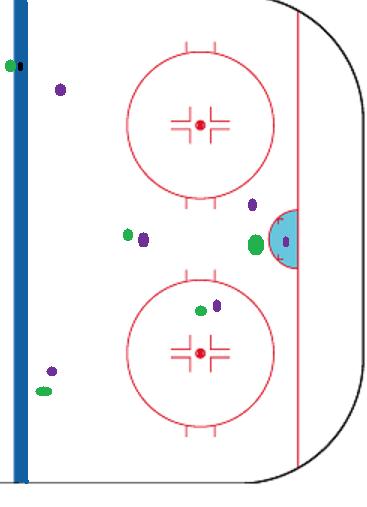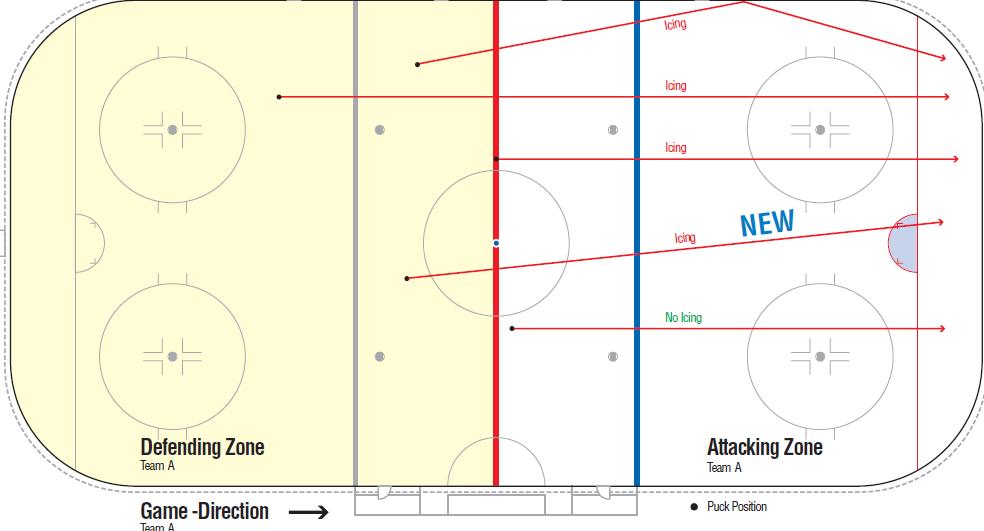Rules: Basic game Play: Offside, Icing and Goals
Offside
A attacking player is offside when they cross the attcking blue line before the puck.
The determing factors to decide whether the player is offside or not are:
1. The players skate posistion: A player is offside when both skates are completely over the blue line in the attacking zone before the puck crosses the line. In the picture below player A (green dot) has attempted to pass the puck (black dot) to player B (blue dot). Player B is in a offside situation therefore play is stopped.

2. The puck posistion: The puck shall have completely crossed the blue line into the attacking zone / neutral zone.
In the picture below the attacking team (green dots) have stopped the puck from leaving the attacking zone by stopping it on the blue line, therefore the play can carry on.

When the play is stopped for offside are face-off is conducted:
1. At the nearest neutral zone face-off spot if the puck was carried over the blue line.
2. At the place where the pass or shot was orginated when the puck was passed or shot over the blue line by the attacking player.
3. At the end face-off spot in the defending zone of the offending team if in the opinion of the Linesmen or Referee if a player has intentionally caused the offside.
4. At the end faceoff spot in the defending zone of the offending team if the puck was passed or shot by the attacking player from their defending zone.
Delayed Offside:
If an attacking player precedes the puck into the attacking zone, but a defending player is able to play the puck, the linesman shall raise their arm to signal a delayed offside, except if the puck has been shot on goal causing the goalkeeper to play the puck.
The Linesmen shall drop their arm to nullify the offside violation and alloy the play to continue if:
1. The defending team to either passes or carries the puck into the neutral zone.
2. All the attacking players immediately clear the attacking zone by making skate contact with the blue line.
Icing the puck

The red centre line divides the ice rink into two halves. The point of last contact with the puck by the team in possesion shall be used to determine whether or not icing has occurred.
Both teams have to have the same numerical strength or superior in stength and shoot, bat, pass or deflect the puck from inside their own half beyond the goal line of the opposing team. Play is then stopped and a face-off is commenced in the offending team's end zone at the side to where the last contact with the puck took place.
No icing is called when:
1. A team is short handed
2. If the puck enters the goal- the goal stands
3. If the puck touches any part of an opposing player or goalkeeper before crossing the line
4. If the puck is iced directly from a face-off
5. If any player from the opposing team, execpt the goalkeeper is able to play the puck before it crosses the goal line
6. The goalkeeper leaves their crease or when the goalkeeper is outside their goal crease during a icing situation and moves in the direction of the puck ( the red line highlighted with NEW)
Goal
When a goal is scored it is either assisted or unassited. A unassisted goal is when a player has not passed the puck before shooting it. A assisted goal is when the puck has been passed between players. The goal scorer is credited with the goal but up to two other players can be credited with assists.
A goal is allowed when:
1. The puck has been put between the goal posts below the crossbar and entirely across the goalline by the stick of a player on the attacking team
2. The puck has been put into the goal in any way by a player of the defending team
3. The puck has been deflected into the goal from a shot of an attacking player by striking any part of a team-mate
4. A player of the attacking team has been physically interfered with, by the action of any defending team and ended up in the goal crease
5. The puck should become loose in the goal crease and then put into the goal by the stick of an attacking player
6. The puck deflects direclty off the skate of an attacking player or defending player
7. A attacking player being in the goal crease at the moment the puck crosses the line and in NO WAY affects the goalkeepers ability to make a save.
No Goal
A goal is disallowed when:
1. The attacking player deliberalty kicks, throws, bats withs hand or otherwise directs the puck into the goal
2. The attacking player made contact with the puck while the stick was above the height of the cross bar
3. The puck has been direclty deflected off an official
4. An attacking player stands or holds their stick in the goal crease when the puck enters the goal
5. The goal frame has been dispalced from its normal posistion or the goal frame is not completely flat to the ice
6. An attacking player iniciates contact with the goalkeeper
7. An attacking player stands in the goal crease to obstruct the goalkeepers vison and ability to make a save
8. The goalkeeper has been pushed over or pushed into the goal
When a goal is scored a face-off takes place at the centre spot. When the goal is disallowed a face-off take place at the end zone spot nearest to the side the save was made.